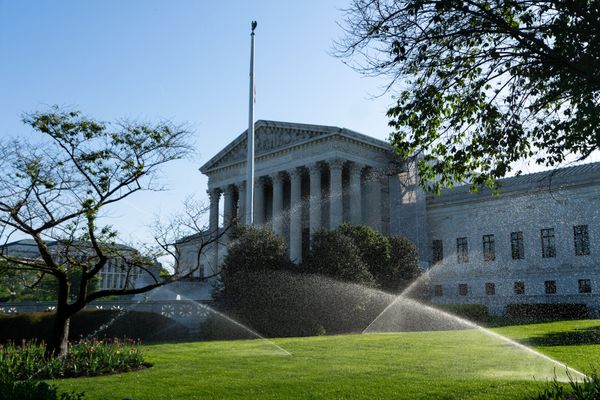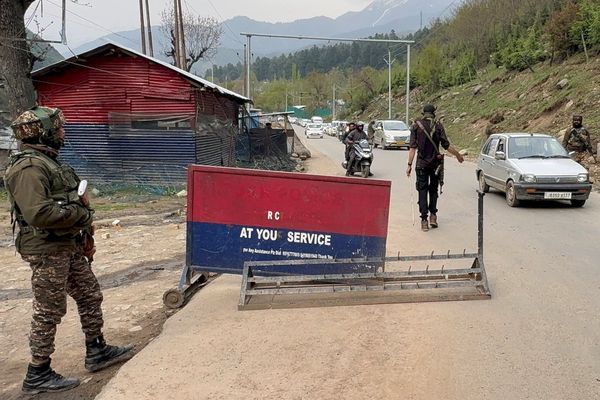PITTSBURGH — Rust corrosion so bad that there were holes in the steel support legs. A bridge deck so compromised by chlorides from winter salt that the concrete underside was decaying and water was seeping through to the steel below. Steel cross-beams “severed” from their connection to the support legs that hold up the bridge.
This was the grim condition of Fern Hollow Bridge in early October 2021, as documented by inspectors who were the last ones to review the bridge’s problems less than four months before it suddenly collapsed on Jan. 28, according to a copy of a partially redacted inspection report provided this week to the Pittsburgh Post-Gazette by the Pennsylvania Department of Transportation in response to a Right to Know request.
Despite those significant structural concerns — documented on 106 pages with scores of color photos — no alarms were raised by inspectors for any immediate repairs, though the findings detail a long list of decaying conditions.
“What I’m wondering is: Why didn’t they close it down?” asked David Beck, a structural engineer based in New Hampshire with more than 50 years of experience in design and construction, after viewing the inspection report at the Post-Gazette’s request.
Pete Giglione, an attorney representing Daryl Luciani, the Port Authority driver who survived the collapse despite his bus falling into the ravine on the bridge, said he was stunned by the inspection report’s findings, calling it “a time bomb.”
The release of the report provides the first glimpse into what the city of Pittsburgh and PennDOT knew about its condition less than four months before the bridge fell and raises questions about what both governments could have done to prevent its failure and the injuries to nine people who were in six vehicles on the span during the collapse.
Pittsburgh City Councilman Corey O’Connor, who has represented the area of Pittsburgh that includes Fern Hollow for 11 years, said he was unfamiliar with the inspection findings that were provided to him by the Post-Gazette. “Even those details you gave me, I was never privy to that” he said, adding that he hoped the city will be more transparent with such information in the future.
“The safety is the priority,” he said.
A spokesman for Gannett-Fleming, the Green Tree engineering firm that performed the inspection, said it could not comment because there is still an active investigation into the bridge’s collapse.
Despite ample evidence that the bridge’s steel structural support legs and cross-bracing were quickly deteriorating and failing, the inspectors kept intact the 26-ton weight limit that had been in place since 2014, writing: “Because the condition of the main load carrying members has not changed significantly, the 2014 Load Rating Analysis is still valid.”
Several engineering experts contacted by the Post-Gazette said they were troubled by the conclusions, saying the inspectors, their supervisors, the city and PennDOT should have taken into account the level of serious deterioration and re-examined the load rating.
“Someone above (the inspectors) should have taken this report and said, ‘We need to do some additional analysis,’ ” said Roberto Leon, a construction engineering professor at Virginia Tech, who reviewed the inspection report at the Post-Gazette’s request. They needed to “go out and completely redo [their] analysis and make sure the load rating is good, because there’s deterioration that’s significant.”
Whether that original weight limit analysis was properly conducted can’t be known because those sections of the report with the data that led to the 26-ton weight limit were redacted by PennDOT.
“I couldn’t believe that,” Leon said. “What are they trying to hide there?”
While much of the report revealed glaring deficiencies, other parts were replete with redactions, including words that described the timing of inspections. The state even blacked out the title of one page that was originally included in the table of contents at the beginning of the report.
Even though the Fern Hollow Bridge no longer exists, Alexis Campbell, PennDOT’s chief spokeswoman, said in an email that some of the information was redacted because it could get in the wrong hands.
“Certain information, if made publicly available, would show fracture critical information ... and otherwise show information about ways in which bridges could be intentionally damaged,” Campbell said.
She added that what was left to read in the report balances “the Administration’s commitment to transparency with appropriate measures that are necessary to protect the safety of the Commonwealth’s infrastructure.”
Many other sections of the report that were redacted appear to be more analytical sections and commentary, and at one point, the state removed the header on two pages but left the phrase “Form F” on top of those pages.
The state’s bridge inspection manual says that Form F is to be used to record findings of “fracture critical members” of a bridge, as well as “fatigue prone details” — key information that can shed light on a bridge’s condition.
Both Beck and Leon said the report itself was thorough and professionally done.
They both noted from the report that even though the concrete bridge deck on top could not be viewed by inspectors because it had been black-topped over by the city, inspectors found troubling signs of deteriorating concrete — or “spalling” — on the underside of the concrete.
“Why you have so much corrosion underneath the deck is concerning, because you’d think it would be pretty protected,” Beck said.
Experts have wondered since the bridge collapsed what the condition of the deck was because the deck functions much like the roof of a house: If the roof goes, the house underneath follows not long after.
A big impact of the significant deterioration of the deck concrete was that more water — particularly chloride-laden liquid from melted snow in winter — would seep through the deck onto the steel superstructure underneath, including the four support legs, which were originally propped up by double-stacked cross-bracing between both sets of legs.
In 2019, the lower cross-bracing between the west end legs of the bridge was removed because it had deteriorated so badly it was hanging detached from the bridge, leaving the top of the bracing on that end, and all of the bracing on the east end. The city had previously tried to better support the deficiency by installing steel cables between each set of legs — a move that multiple experts have questioned since the disaster.
The 2021 inspection report says, however: “The remaining cross bracings are in poor condition. The cross bracing exhibit uneven weathering, laminar rust, severe corrosion and holes in webs at bracing connections. The cross bracing is deteriorating due to malfunctioning drainage systems in addition to deterioration, contamination and seepage through the deck concrete (previously noted).”
In addition, the inspection found, the four steel legs also showed significant deterioration, noting: “The frame legs are in poor condition. The frame legs exhibit laminar rust and holes in the webs. There are five (5) stiffeners at each bent leg that exhibit 100% section loss."
Stiffeners are small slices of steel that are placed horizontally up and down the legs as part of a waffle-like system of additional support to the main steel leg beams.
Another finding by inspectors, documented with a photo, was of “Up to 50% section loss to bolts on the inside of girder splice plate” that connects the west end of the bridge to the central portion.
A “splice plate” is an important part of a bridge’s construction that joins its major horizontal spans, binding them together with bolts, rather than welds.
Losing 50% of the bolts “to me is also very troubling,” Leon said. “If they’re saying 50% of the bolts of the splice on a main beam are rusted out, that means that that beam has only 50% of its carrying capacity and that is where it could fail.”
“The inspection itself is good,” said Leon. “But there are troubling signs here that should have gotten people into action.”
———







